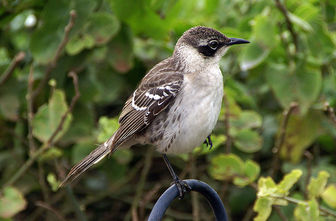Galapagos Mockingbird
The Galápagos Mockingbird is a species of bird in the Mimidae family. It is endemic to the Galápagos Islands, Ecuador.

Original source: putneymarkPermission(Reusing this file)This image, which was originally posted to Flickr.com, was uploaded to Commons using Flickr upload bot on 23:35, 16 April 2008 (UTC) by Snowmanradio (talk). On that date it was licensed under the license below. This file is licensed under the Creative Commons Attribution-Share Alike 2.0 Generic license.You are free:to share – to copy, distribute and transmit the work
Author: putneymarkPermission(Reusing this file)This image, which was originally posted to Flickr.com, was uploaded to Commons using Flickr upload bot on 23:35, 16 April 2008 (UTC) by Snowmanradio (talk). On that date it was licensed under the license below. This file is licensed under the Creative Commons Attribution-Share Alike 2.0 Generic license.You are free:to share – to copy, distribute and transmit the work
The Galapagos Mockingbird is classified as Least Concern. Does not qualify for a more at risk category. Widespread and abundant taxa are included in this category.
The Galapagos Mockingbird is easily spotted on the Galápagos Islands due to its feathers which are streaked brown and gray, long tail, and smaller size, and black, angled beak. The bird has a darker color than other mockingbirds on the islands causing it to blend in with the coral sand of the islands that it mainly inhabits. Its natural habitats are subtropical or tropical dry forests and subtropical or tropical dry shrubland. More
* Galapagos Mockingbird (Mimus parvulus): Found among the majority of islands, except those where one of the other species resides. The ranges for each mockingbird species do not overlap. * Floreana mockingbird (Mimus trifasciatus): This species is extinct on Floreana Island, but continues on its two satellite islets, Champion and Gardner-by-Floreana. These birds nest in Opuntia cacti. More
Galapagos Mockingbird Classification Kingdom: Animalia Phylum: Chordata Class: Aves Order: Passeriformes Family: Mimidae Genus: Mimus Species: m. More
Galapagos mockingbird perched on Opuntia cactus Galapagos mockingbird perched on Opuntia cactusPrint factsheet Facts - Synonyms: Nesomimus parvulus, Nesomimus transfasciatus Kingdom Animalia Phylum Chordata Class Aves Order Passeriformes Family Mimidae Genus Mimus (1) More
Endemic to the Galapagos Islands, the Galapagos mockingbird is found on most of the major islands except those inhabited by one of the other three mockingbird species (2) (5). The different subspecies are found on separate islands: Mimus parvulus parvulus is found on most of the central islands including Santa Cruz, North Seymour, Isabela and Fernandina; M. p. personatus is found on Pinta Island; M. p. barringtoni is found on Santa Fe Island; M. p. bauri is found on Genovesa Island; M. p. More
The Galapagos mockingbird (Nesomimus) has various races or subspecies on the different islands, showing an adaptive radiation similar to, but not as extreme as, that... More
The Galapagos Mockingbird is endemic in the Islands. Mockingbirds are omnivorous, but they occasionally exhibit aggressive, predatory behavior. They will eat just about anything: seeds, insects, baby turtles, young finches, and sea lion placenta. The Galapagos Mockingbird inhabits most of the main and northerly islands, while there are distinct species on Hood, San Cristobal and two smaller islands off Floreana. More
The Galapagos mockingbird (Nesomimus parvulus, above) is the most widespread of the four species More
the Galapagos Islands, but the Galapagos Mockingbird is the first one that was found in Darwin More
The Galapagos Mockingbird (Nesomimus parvulus) is a species of bird in the Mimidae family. It is endemic to Ecuador. Description - The Galapagos Mockingbird is easily spotted on the islands due to their feathers that are streaked brown and gray, long tail, and smaller size, slimness, and black, angled beak. More
